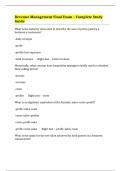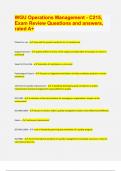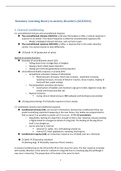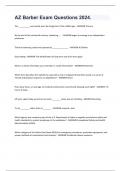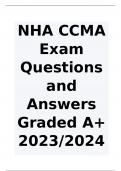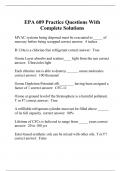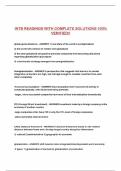Problem 1
Part 1: Zimmerman - Attaining Self-Regulation
Introduction
• The chapter addresses common dysfunctions in SR and its developmental aspects
• Aim: Define self-regulation, explore the structure of SR systems, and examine environmental
influences.
A. A Triadic Definition of Self-Regulation
• SR → Interplay of personal, behavioral, and environmental processes.
o Not just behavioral skills → Also the knowledge and personal agency for effective
self-management.
o Involves self-generated thoughts, feelings, and actions aimed at achieving goals.
o This concept differs from other definitions that focus solely on traits, abilities, or
competence stages.
• The process of SR varies depending on performance performances → Beliefs and motives.
o Encompasses self-beliefs and affective reactions → critical in specific contexts.
• Self-efficacy is a key component of SR
• The cyclical nature of SR → Using feedback from past performance to adjust current efforts.
o Personal, behavioral, and environmental factors change during learning and
performance, requiring constant self-monitoring and adjustment.
o SR includes behavioral, environmental, and covert (cognitive and affective) self-
monitoring and adjustment.
• The effectiveness of strategic adjustments in SR is influenced by the accuracy and constancy
of self-monitoring.
• SR involves both reactive and proactive adaptations for goal attainment (seeking more
challenging tasks to improve skills)
, 3.3 Motivation, Self-Regulation, Performance - GPT-Notes
II. The Structure of Self-Regulatory Systems
• Every person attempts to self-regulate their functioning to achieve life goals.
• No such thing as un-self-regulated individuals → Difference lies in quantity and quality of SR
o Effective SR → Quality and quantity of SR processes.
• SR processes and beliefs can be categorized into three cyclical phases: forethought,
performance or volitional control, and self-reflection processes.
o Forethought → Precede actions and set the stage for them.
o Performance or volitional control → Occur during motoric efforts and impact
attention and action.
o Self-reflection → Occur after performance efforts and influence a person's response
to their experience.
▪ Self-reflections → Influence forethought → More motoric efforts →
completing a self-regulatory cycle.
A. Forethought Phase
• Forethought in SR includes → 1. Task analysis 2. Self-motivational beliefs
Task Analysis:
• Goal setting
o Key form of task analysis → Involves the decision of specific performance outcomes
o Highly SR ppl organize their goals hierarchically → Process goals regulating outcome
goals.
o Process goals → Not mechanical checkpoints → Hold personal meaning, indicating
progress.
• Strategic planning
o Another form of task analysis → Involves the selection of appropriate strategies for
skill acquisition and performance.
o SR strategies enhance performance by aiding cognition, controlling affect, and
directing motoric execution.
o The selection of strategies → Requires cyclical adjustments due to changes in
personal, behavioral, and environmental factors.
, 3.3 Motivation, Self-Regulation, Performance - GPT-Notes
Self-Motivational Beliefs:
• Key self-motivational beliefs: i. self-efficacy; ii. outcome expectations; iii. intrinsic interest iv.
goal orientation
i. Self-efficacy → Beliefs about one's capability to learn or perform effectively.
• Self-regulatory efficacy influences the use of various regulatory processes.
o Self-efficacy beliefs influence goal setting
o Higher self-efficacy leading to higher goals and stronger commitment.
▪ Self-efficacious people increase efforts when falling short of goals
▪ Self-doubters tend to withdraw.
ii. Outcome expectations → Beliefs about the consequences of performance.
iii. Intrinsic interest → Process goals can become IM and can outweigh outcome goals.
iv. Process goal orientation → Sustains motivation and improves acquisition and performance.
o Provides a sense of IM or valuing that can surpass extrinsic outcomes.
B. Performance or Volitional Control Phase
• Two types of processes → (1) Self-control and (2) Self-observation.
(1) Self-control processes → i. self-instruction; ii. Imagery; iii. attention focusing; iv. task strategies.
o Self-instruction → Describing how to proceed while executing a task and can improve
learning.
o Imagery → Forming mental pictures to assist encoding and performance.
o Attention focusing → Improve concentration and screen out distractions.
o Task strategies → Help by reducing a task to essential parts and reorganizing them
(2) Self-observation → i. Self-recording; ii. Self-experimentation
i. Self-recording → Common self-observational technique → Enhances feedback
quality.
ii. Self-recording leads to cycles of self-experimentation → When natural variations in
behavior don't provide decisive diagnostic information.
• Systematic self-observation and experimentation → Greater personal understanding and
better performance or volitional control.
• Helps identify recurrent patterns in functioning and influential environmental features.
• Features influencing self-observation effectiveness: Temporal proximity, informativeness of
feedback, accuracy, and valence of behavior.
, 3.3 Motivation, Self-Regulation, Performance - GPT-Notes
C. Self-Reflection Phase
• Bandura (1986) identified two self-reflective processes: i. self-judgment; ii. self-reactions.
o Self-judgment → Self-evaluating performance and attributing causal significance.
▪ Self-judgement depends on sensitivity, and experts set challenging criteria.
o Four types of criteria for self-evaluation: mastery, previous performance, normative,
and collaborative.
o Attributional judgments → Pivotal and depend on cognitive appraisal of factors like
personal efficacy.
▪ Forethought processes impact attributional judgments, with strategy use
influencing attributions.
o Self-reactions → Self-satisfaction and adaptive inferences.
▪ Self-reactions cyclically impact future courses of action, influencing
motivation and goal attainment.
▪ A cyclical social cognitive model explains the persistence of achievers and
the avoidance of nonachievers.
o Self-satisfaction → Important for motivation and goal-directed actions.
o Adaptive inferences → Guide people toward better forms of self-regulation
▪ Defensive inferences → Limit personal growth.
III. Social and Environmental Influences on Self-Regulation
• Key feature of the social cognitive model of SR: Interdependence of social, environmental,
and self-influences.
• Self-initiated processes can alter the social and physical environment → In turn, affected by
those changes.
• Viewing social and environmental resources as obstacles → Hinder effective SR.
• Internal views of SR functioning (willpower beliefs) may lack awareness of social and
environmental influences.
• The social milieu influences SR processes through standards formed based on instruction,
social feedback, and modelling (peers, family, teachers, and coaches)
• People can increase their self-reactions using environmental supports (self-administered
rewards and praise)
• Tangible self-rewards are designed to boost reactions performance and outcome
expectations.
• Social and physical environments are seen as resources for enhancing forethought,
performance control, and self-reflection.
• Modelling and instruction play a crucial role in conveying SR skills, while negative social
models or groups can lead to personal dysfunctions.



